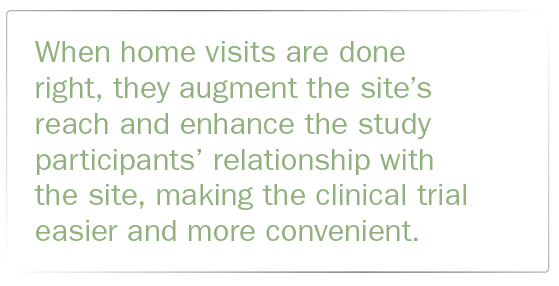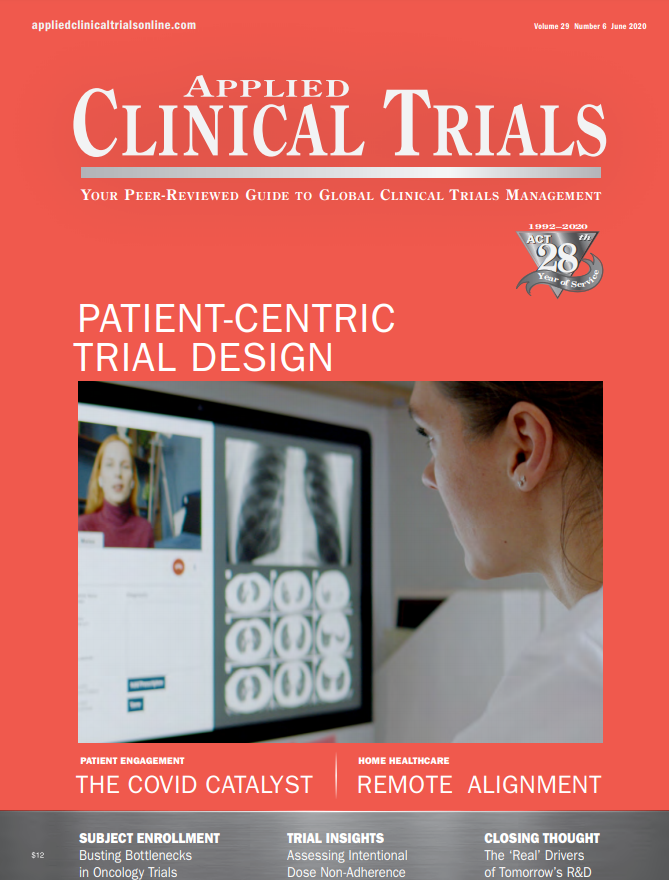How to Keep Home Healthcare on Target
Aligning approaches in quality, control, and oversight to get the most out of including home visits in clinical trial protocols.

Home visits have the power to ease the clinical trial process for patients, but complex study design, tight timelines, busy clinical operations teams, and overburdened sites can sometimes make home health feel like yet another moving piece to manage. As COVID-19 restrictions continue to force sponsors and study teams to pivot clinical trials in progress (and consider precautionary adjustments to any new study designs), home visits are being offered as a critical solution for already scheduled drug administration or other types of protocols.
Sites have expressed concerns in recent surveys that home visits aren’t practical, but fears over widespread site closures may be influencing responses. Sponsors, however, are increasingly concerned about losing their data for ongoing studies.
Missed visits can mean starting a clinical trial over despite millions of dollars already sunk into study progress pre-pandemic.
Incorporating a home visit component is clearly a viable way to continue additional dosing, blood work collection, or other protocol activities and assessments. Contrary to the concerns of some sites, adding home visits to clinical trials in progress could actually prevent paused studies and resulting site closures from taking place.
This article aims to demystify (and de-risk) home visits for sponsors and sites that are considering changing protocols for existing clinical trials and for those interested in including home visits in any new clinical trials. Understanding how to approach home visits will ensure sponsors, sites, and home visit providers are in alignment regarding quality, control, and oversight-and that is the best way to keep studies with a home visit component on target.
Establish the timeline
The timeline is always one of the first things sponsors ask about, whether the conversation is taking place prior to the protocol being written, post-study design but pre-first-patient-first-visit, or even mid-study, as is the case with rescues or those threatened by COVID-19 restrictions. And setting realistic timing expectations is critical to making the home visit aspect run smoothly.
Today, there is a completely understandable desire to start up home health services very quickly. Starting from zero, however, still typically takes several weeks at minimum and requires candid communication between the sponsor and home visit service provider. Establishing timing should never be one-sided, and anything less than a partnership from day one will increase the likelihood of issues later on.
The key point to remember is there is tremendous variability. Individual variables that play a large role in establishing timelines can include factors like:
- Amount of protocol-specific training required.
- Level of engagement during a visit.
- On-site processing requirements.
- Drug or sample stability.
- Recruitment goals.
Very simple studies can be up and running in a month or two, and incredibly complex studies can take six months or more. If the protocol consists of patients taking a simple dose of pills, that will obviously require a completely different timeline than a daily infusion. The former would require very little training and a few weeks of preparation, and the latter several weeks just for training alone.
In the current climate, especially, sponsors should be wary of overly aggressive timeline claims that don’t also come with a thorough project plan. The project plan should link directly to the associated timeline and consider all the potential weak links or pitfalls that could arise.
Understand what a home visit can and cannot do
While having a home visit option can improve how patients feel about trial participation, home visits are not ideal for every clinical trial. Protocols that require imaging equipment or a sliding scale only a board-certified neurologist can apply can only be done at a site. Additionally, some countries restrict certain medical procedures from being performed in a home setting. That said, many sponsors are surprised to learn the depth and breadth of procedures that can be handled at a home visit, especially as it relates to blood samples and investigational product.
In addition to simple procedures like physical exams, blood draws, and collection of vital signs, a high-quality home visit team can perform post-blood-draw preparation such as centrifuging or aliquoting. Home visit nurses can also perform intraperitoneal (IP) injection, including working with carefully temperature-controlled medications or those that have to be reconstituted right before application.
Home visits can even be combined with existing telemedicine technology, allowing a hybrid virtual home visit. A physician or site study staff could conduct a telemedicine assessment while other data is collected concurrently by the in-home nurse.
Almost anything that can be taught in a straightforward training session with a nurse is possible. What can and cannot be done during a home visit often comes down to balancing a reasonable level of training and equipment within budget. If the protocol would require an in-home nurse to attend weeks of training to support a visit or the equipment required is not portable, that would have a significant impact on the cost of implementation.
Ensure protocol compliance
Home visits, by their very nature, help ensure protocol compliance. Visits need to happen within a specified time frame, and it is much easier for patients to maintain the right number of visits within the right time frame when the visits come to them. Take away the reliance on study participants to make site appointments and you take away a common compliance pitfall.
Fully assessing the training program of your home visit provider is also a critical step for sponsors and investigators. While home healthcare nurses are already skilled at administering typical procedures such as physical exams and vital signs, the protocol-specific training should include everything from the procedures that need to be completed, to being sensitive to participants’ physical or mental state, to good clinical practice (GCP) guidelines. And all training should be to the full satisfaction of the principal investigator overseeing the study.
Since sites are still responsible for the conduct of home visits from a regulatory perspective, there is often a concern about how they can remain in control of the progress without overwhelming the already busy study team and staff.
Approaching home visits as an extension of the site gives the entire engagement critical context. The home visit provider and nurses should understand they are working on behalf of the site but are also accountable for the role they fulfill.
From there, it is a matter of confirming the following:
- The home visit provider has a well-established method for opening candid lines of communication between the site, the home healthcare nurse, and the home visit provider’s project coordinator.
- Expectations are clear and there are quality-based key performance indicators (KPIs) in place.
- All data will flow quickly, efficiently, and accurately to the site.
- The home visit provider has tools and resources in place that guarantee that visits go smoothly.
Sites should not feel the need to micromanage the home visit details to ensure protocol compliance, and they should sacrifice nothing in terms of control, quality, or oversight. When home visits are done right, they augment the site’s reach and enhance the study participants’ relationship with the site, making the clinical trial easier and more convenient.
Engage stakeholders in study design
When deployed with thoughtful planning, communication, and partnership, the home visit component should not be difficult to keep on target at all. In addition to the approaches already outlined, the most important key to making home visits work is listening to the needs of the patients. That requires engaging with participants

and a home visit provider early and including them as stakeholders in the study design so protocols can be crafted to deliver research insights in a way that is as patient-centric as possible.
Home visits are not a panacea. Not everyone wants a nurse coming into their home. However, when home visits are applied appropriately and incorporated intelligently and with flexibility, they can leave study participants with a more positive impression of the research being conducted-and enhance the successful completion of the clinical trial.
Michael Woods is CEO, Firma Clinical Research

Improving Relationships and Diversifying the Site Selection Process
April 17th 2025In this episode of the Applied Clinical Trials Podcast, Liz Beatty, co-founder and chief strategy officer, Inato, discusses a number of topics around site engagement including community-based sites, the role of technology in improving site/sponsor relationships, how increased operational costs are impacting the industry, and more.
Behind the Buzz: Why Clinical Research Leaders Flock to SCOPE Summit
February 7th 2025In this episode, we meet with Micah Lieberman, Executive Conference Director for SCOPE Summit (Summit for Clinical Ops Executives) at Cambridge Innovation Institute. We will dive deep into the critical role of collaboration within the clinical research ecosystem. How do we bring together diverse stakeholders—sponsors, CROs, clinical trial tech innovators, suppliers, patients, sites, advocacy organizations, investors, and non-profits—to share best practices in trial design, program planning, innovation, and clinical operations? We’ll explore why it’s vital for thought leaders to step beyond their own organizations and learn from others, exchanging ideas that drive advancements in clinical research. Additionally, we’ll discuss the pivotal role of scientific conferences like SCOPE Summit in fostering these essential connections and collaborations, helping shape the future of clinical trials. Join us as we uncover how collective wisdom and cross-industry partnerships are transforming the landscape of clinical research.
FDA-Approved Gene Therapy Beqvez Shows Sustained Efficacy, Safety in Long-Term Hemophilia B Trial
April 17th 2025Beqvez (fidanacogene elaparvovec), an FDA-approved one-time gene therapy for hemophilia B, demonstrated sustained factor IX expression, low bleeding rates, and a favorable safety profile over long-term follow-up.